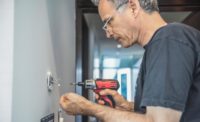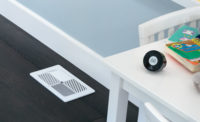Panel of Industry Professionals
The NEWS enlisted the aid of several industry experts to bring perspective to the growth of this market and the prospects for future growth. The experts include Bob Swilik, manager of advanced systems, Carrier; Stuart Lombard, president and CEO, ecobee; Brad Paine, director, energy management and connected systems, and Rob Puric, director of residential security marketing, Honeywell; Brett Worthington, director of business development, Ingersoll Rand Residential Solutions; Tom Jackson, CEO Jackson Systems; Jamie Byrne, vice president Trane sales Residential Solutions; and Geoff Godwin, VP marketing, White-Rodgers, a business of Emerson Climate Technologies.
Smart Phones and Tablets Are Market Drivers
Home automation, temperature control from a remote location, and wireless thermostat technology have been around for a few years, but the growth in interest and sales has been driven by the massive growth of mobile devices like iPhones, Android phones, and other smart phones and iPads and other tablet computers. Worthington sees a big shift in the way people stay connected, and he shared some key statistics from a 2011 Parks Associates Research study and other company research including:
• Fifty-two percent of all mobile consumers over 18 in North America now have smart phones.
• Over 24 million people own tablet devices.
• Seventy-seven percent of consumers surveyed would like the ability to remotely monitor their home while away.
• There will be 110 million smart phones by 2015.
Most homeowners have wireless access, and a vast majority will likely be looking to download an app that enables them to monitor what is going on inside and outside their homes. Lombard cited statistics from Apple showing over 6 billion apps have been downloaded to
iPhones and iPads within a 24-month period. “This shows that people are changing the way they live. The iPhone has become the remote control of peoples’ lives,” he said.
There is also the new product Nest that is helping to create buzz in the wireless thermostat market. The product was developed by former engineers from Apple Computer, and they have been extensively marketing it directly to the consumer market. According to Jackson, “The things that it has going for it are the ability to monitor from the Internet, it learns the homeowner’s schedule and programs itself, and it has a real sleek appearance.”
Products for Connectivity and More
There are several wireless products available on the market today that bring home connectivity solutions. Here is an overview of some of the popular devices:
• Carrier Infinity touch control provides integrated wireless capability so homeowners can access their heating and cooling systems from virtually anywhere with a Wi-Fi network, helping to maximize energy savings when the space is not in use. It also has a Smart Setback feature that helps homeowners remotely reduce energy use and save money on utility bills during peak usage periods.
• ecobee SmartSI thermostat is Wi-Fi-enabled, has a 2.4-inch color touch screen, a push-button interface controls up to three stages of heating, and does not control humidification and dehumidification, like ecobee’s Smart Thermostat. Automatic alerts and reminders notify you when your HVAC equipment is due for service, if there is an equipment malfunction, or when it’s time to change the filter.
• Honeywell RedLINK™ Internet gateway enables contractors to connect any RedLINK Comfort System to the Internet to provide remote access and works with the Prestige line of thermostats. A new feature allows users to remotely monitor and control heating and cooling along with whole-house humidifiers, dehumidifiers, and ventilation. Honeywell has also announced a Wi-Fi version of the VisionPRO® product, which is scheduled to be on distributor shelves in October 2012.
• Jackson Systems T-32-P universal thermostat is compatible with most residential HVAC systems and has advanced features such as integrated Modbus communications that can provide web-based remote access when used in conjunction with the Jackson Systems WEB Comfort system.
• Trane ComfortLinkII™ control features a high-definition color touch screen, zoning capability, advanced scheduling, digital picture display capabilities, live weather forecasts, wireless connectivity, and remote operation from most web-enabled computers or smart phones. It also has Quick Clean and Allergy Clean cycles that acts as a temporary boost to air filtration.
Home Automation + HVAC
The growth of Internet-connected devices is also pulling HVAC contractors into the home automation market, which has been dominated by companies that focused on high-tech audio visual products and home security. Home automation companies such as Crestron and Control4 reside at the high end of the market with systems that can exceed $50,000. According to company literature, Crestron Electronics is a leading provider of control and automation systems for homes, offices, schools, and hospitals. Control4 claims a distribution channel of 2,200 North American custom integrators, retailers, and distributors in 73 countries. Their customer base is steeped in iPads and iPhones, and they demand remote control of the HVAC system in their prime residences and their vacation homes as well. Although this market is not in most HVAC contractors’ sweet spot, according to The NEWS’ research, several contractors have formed informal partnerships with home automation dealers, and this has resulted in high-end
HVAC customers.
Down at the DIY end of the scale, there is also a home automation boom going on. Lowes recently announced the introduction of Iris, a home automation system in 500 of their stores. According to a recent article from McClatchy Newspapers, “Iris gives users the ability to use a computer or mobile device to remotely control and monitor systems such as thermostats, door locks, power consumption, cameras, and motion sensors.” In addition to Lowes, Time Warner Cable, Verizon, and Comcast are offering smart home systems.
There is an HVAC-related entry in this market called Nexia Home Intelligence, which combines technological developments by two Ingersoll Rand companies, Trane, and Schlage. Nexia is built on a wireless technology known as Z-Wave, which communicates with devices such as thermostats, door locks, and cameras and translates it into a simple control the homeowner can manage via the Internet. According to the company, the Z-Wave technology enables the homeowner to add other products as their needs change. Byrne said, “By simplifying the complex task of home automation and networking, we’ve successfully opened a door into an entirely new solutions arena.”
What’s on the Horizon?
There is a consensus among our panel of industry experts that this whole market segment is poised to take off and will represent 50 percent of the entire thermostat market by 2015. Swilik said, “The ability to control an HVAC system from a cell phone or other wireless device will become a standard function in the marketplace as we look to the future.” This evolution will have an impact on the consumer and the contractor. Paine of Honeywell predicted, “What this means is an all-around better experience for the consumer in the form of a higher level of comfort, convenience, energy savings in the heating and cooling system, and for the dealer a better overall experience with installations and service calls. That is what will really drive this market.”
HVAC contractors will play a key role in the home automation market, and Puric urged them to proactively approach partnerships on the security and automation side of the business because these dealers are going to need support as the market moves forward. He said, “They [security and home automation dealers] are often fearful of the HVAC system. Why? Because they don’t want to get the [customer] call at three in the morning complaining their air conditioning doesn’t work. That’s not their forte.”
Some of our crystal-ball gazers also predicted the emergence of a common communications protocol that will allow a variety of wireless products and systems to communicate with each other, with the homeowner, and with the servicing contractor to allow for preventive maintenance. Godwin said, “Emerson is still very committed to getting open standards adopted in the market. The ClimateTalk Alliance has about 25 companies working together to get this standard written and adopted. I know some of the OEMs continue to promote closed proprietary protocols, but eventually we, as an industry, will need open standards to move ahead in the areas of connectivity and efficiency.”
What’s in it for the Contractor?
Investing time, effort, and money in home connectivity and automation provides benefits beyond selling upgraded controls and systems. It allows contractors to develop new and long-lasting relationships with customers. If a device has the capability to communicate with the homeowner, it can provide diagnostics for the HVAC contractor. This sets up a digital relationship that results in regularly scheduled maintenance, preventive maintenance, and opportunities to fine-tune systems to maximize comfort and energy efficiency.
For more information, go to www.carrier.com, www.control4.com, www.crestron.com, www.ecobee.com, www.emerson.com, www.forwardthinking.honeywell.com, www.jacksonsystems.com, www.nest.com, www.nexiahome.com, and/or www.trane.com.
Publication date: 8/20/2012










